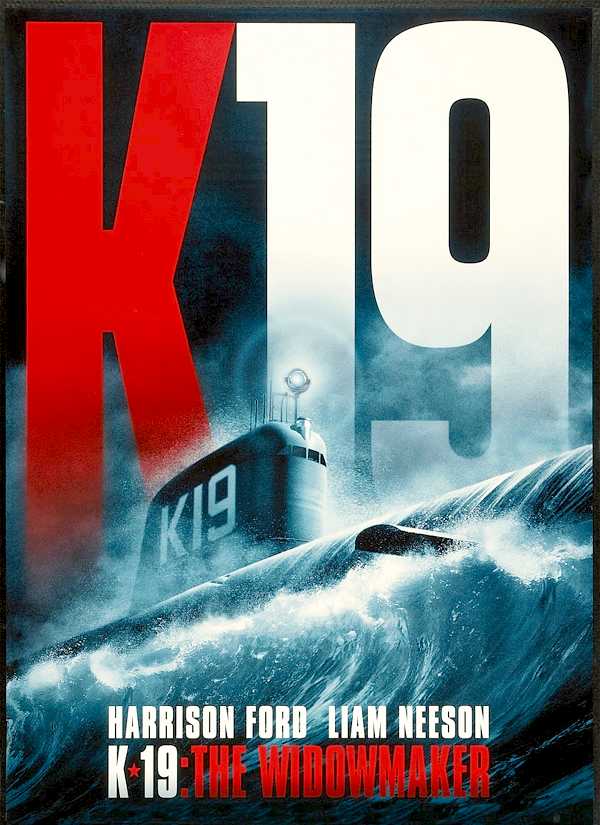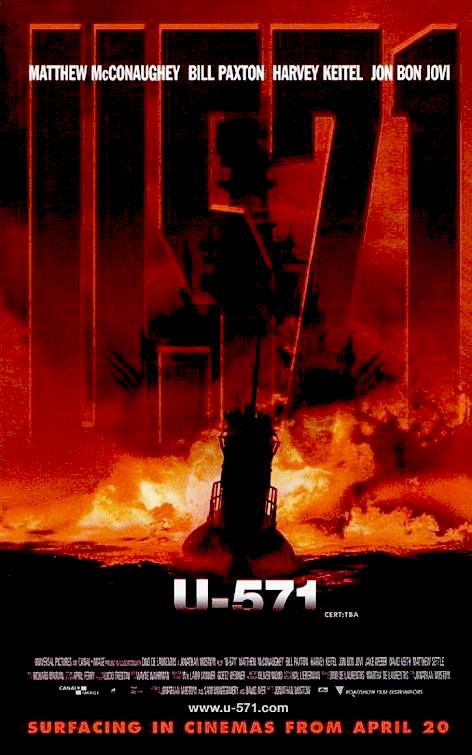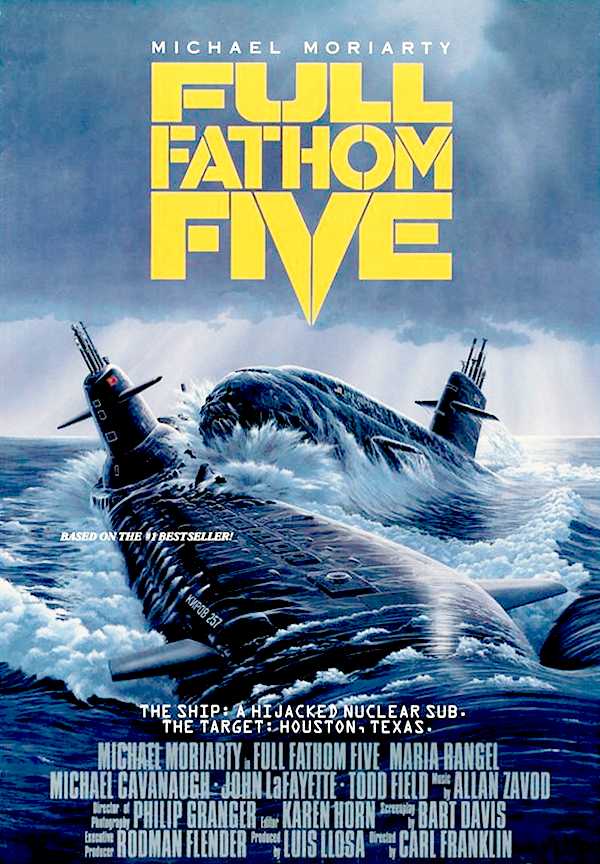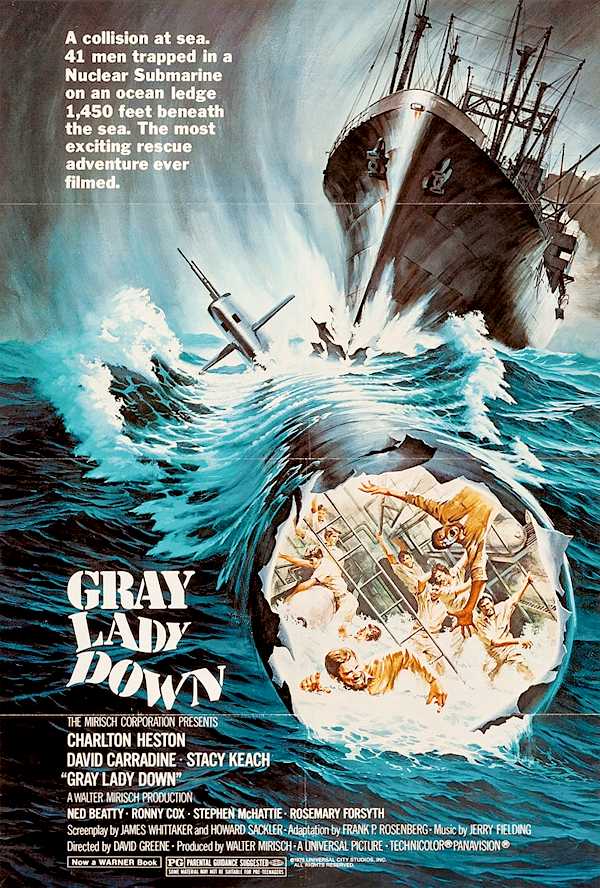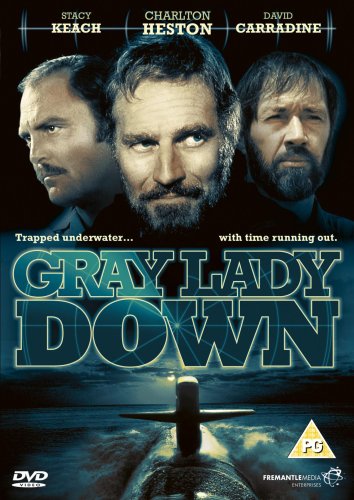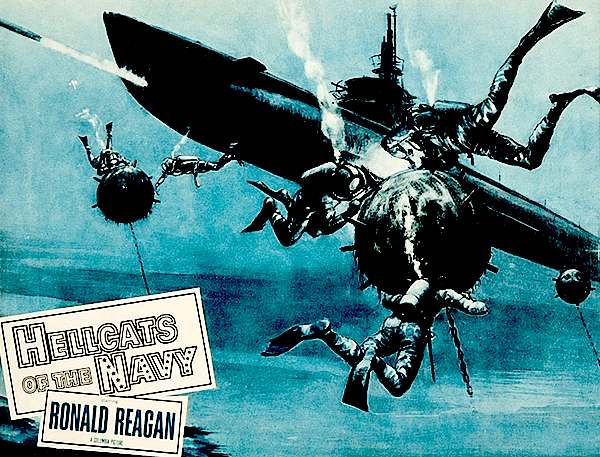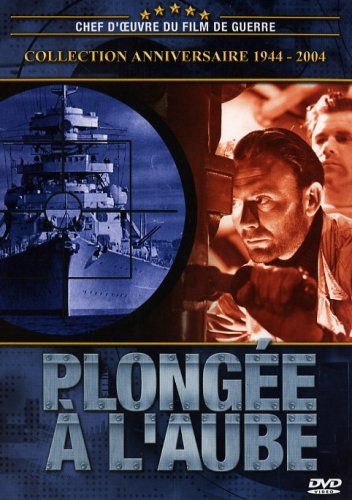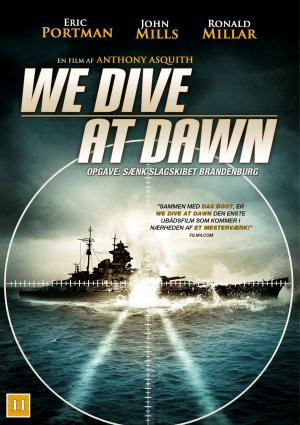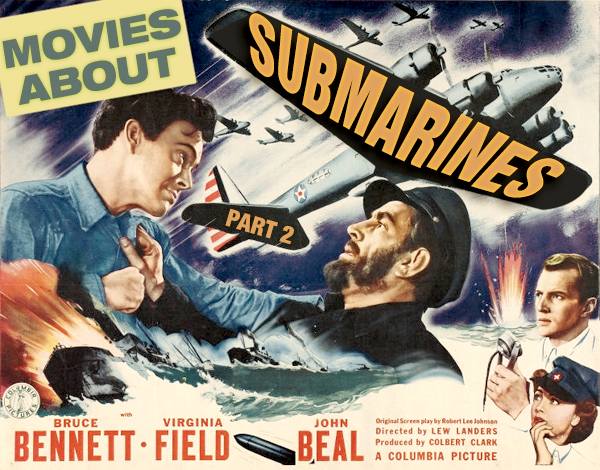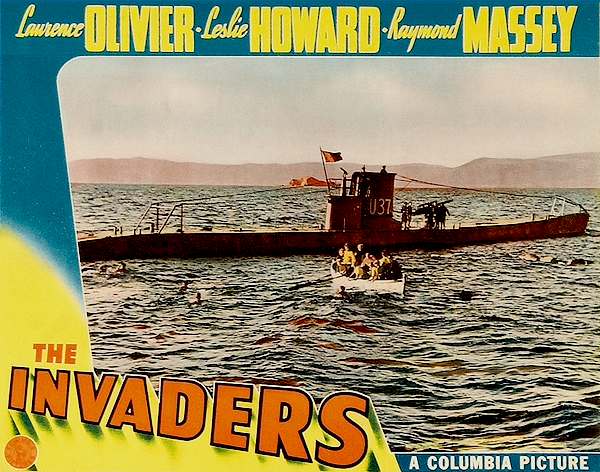SUBMARINE MOVIES OF NOTE
WHAT MAKES A SUBMARINE MOVIE
Submarine films are a subgenre of war film in which the majority of the plot revolves around a submarine below the ocean's surface. Films of this subgenre typically focus on a small but determined crew of submariners battling against enemy submarines or submarine-hunter ships, or against other problems ranging from disputes amongst the crew, threats of mutiny, life-threatening mechanical breakdowns, or the daily difficulties of living on a submarine.
The danger from the extreme pressure of deep water dives and the claustrophobic, cramped submarine quarters imbues films of the subgenre with a great deal of dramatic tension. To heighten this tension, these films often depict submarine commanders descending below "hull crush depth" to evade attackers. Films from this subgenre tend to feature dramatic scenes in which submarine-hunters try to destroy submarines with depth charges. A stock scene in the submarine genre film is the depiction of a grim-faced submarine crew waiting in silence as depth charges explode overhead and bolts fly out of bulkheads in the submarine (they are dead silent because sound carries extremely well underwater, and so even the sound of men talking on a submarine would be picked up by normal sonar on other ships). Modern (post-World War II) movies often add conflict between different enemies.
Also a typical feature in all depicted eras is the sudden switch from hunter to hunted; while stalking enemy ships or carrying deadly nuclear missiles, the submarine often becomes, within moments, the hunted victim of overwhelming attack, the crew fleeing for its collective life.
While submarine films do use dramatic battle scenes, much of the tension in these movies tends to be created using other devices, such as conflict between officers, a threatened mutiny, damage to the boat, or life-threatening problems with the diving equipment or the engines/nuclear reactor. This sets this sub-genre apart from its parent genre of war films, which tend to focus more on battle scenes. Several submarine films use occasional 'dark humor' as comic relief to the tension, in common with other war films.
FAMOUS SUBMARINE MOVIES - UP PERISCOPE
About once every four years a submarine based movie is released. Most of these were shortly after World War Two. There has though been a recent revival of naval movies with CGI reducing the cost of production and improving the general feel of realism, where in the past large scale models did not quite submerge us.
K19 THE WIDOWMAKER, PARAMOUNT 2002 - Harrison Ford stars as a Russian naval officer who, at the height of the Cold War in 1961, has been given command of the Soviet Union’s first nuclear submarine, K-19. The vessel’s previous commander, played by Liam Neeson, has been demoted to executive officer because of his outspoken assertions that the flagship is not yet ready for deployment. Political pressure forces Vostrikov to sail his crew into the North Atlantic for a missile fire test, intending it to serve as a warning to the U.S. that its enemy is now its technological equal. The test is a success, but a disastrous leak in the K-19′s reactor cooling system soon threatens to ignite the sub’s nuclear payload. An event which would certainly be mistaken for an opening salvo, sparking World War III.
U-571, DINO DE LAURENTIS 2000 - The film was directed by Jonathan Mostow, starring Matthew McConaughey, Bill Paxton, Harvey Keitel, Thomas Kretschmann, Jon Bon Jovi, Jack Noseworthy, Will Estes and Tom Guiry. In the film, a World War II German submarine is boarded in 1942 by disguised United States Navy submariners seeking to capture her Enigma cipher machine. The film was financially successful and generally well-received by critics in the USA and won an Academy Award for sound editing. The fictitious plot attracted substantial criticism since, in reality, it was British personnel from HMS Bulldog who first captured a naval Enigma machine (from U-110 in the North Atlantic in May 1941), months before the United States had even entered the war. The anger over the inaccuracies even reached the British Parliament, where Prime Minister Tony Blair stated that the film was an "affront" to British sailors.
FULL FATHOM FIVE, NEW HORIZONS 1990 - Based on the novel by Bart Davis, and set in the days before the US invasion of Panama in 1989. Panamanian rebels seize a Soviet submarine (the “Victor Three class submarine CCCP Kirov“) and threaten America with a nuclear attack on Houston, Texas. Only commanding officer Peter MacKenzie (Michael Moriarty) of the USS Aspen, a fictional Los Angeles-class submarine, can stop the villains. In the film technical accuracy is lax. The submarine warfare tactics used are absurd and the military structure, uniforms, insignia, and jargon are imaginary. The novel does not have these technical flaws, and has been published in several languages, including Chinese and Japanese.
GRAY LADY
DOWN, UNIVERSAL 1978 - Based on David Lavallee’s book Event 1000. An aging, respected commander Paul Blanchard, (Charlton Heston) on his final tour before promotion to squadron command. Surfaced just off the coast of Rhode Island, his boat, the USS
Neptune (fictional), is struck by a freighter in heavy fog, and sinks to a depth of 1,450 feet, (442 meters) before coming to rest on a canyon ledge above an even deeper trench.
A US Navy rescue force, commanded by Captain Bennett (Stacy Keach), arrives on the scene, but a sub-sea landslide has rolled the Neptune to such an angle that is now inaccessible. A small but capable experimental submersible, the Snark, run by a nonconformist Navy misfit Captain Gates (David Carradine) is brought in to assist with the rescue.
Submarine special-effect footage and the large-scale model originally used to portray the fictional submarine USS Tigerfish in the
1969 movie, Ice Station Zebra, is
reused.
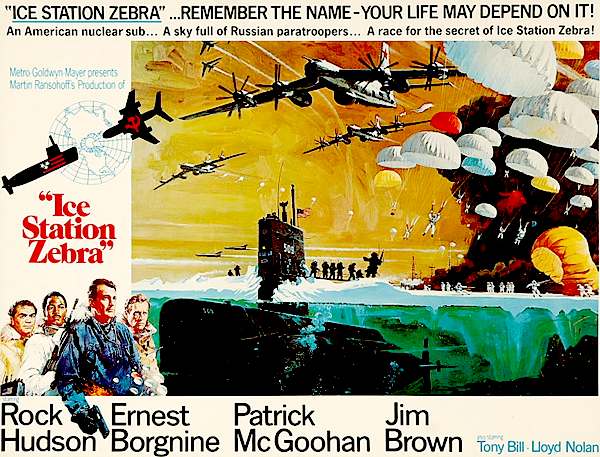
ICE STATION
ZEBRA, MGM 1969 - A cold-war era suspense and espionage film loosely based upon
Alistair MacLean‘s 1963 novel of the same name. Both have parallels to real-life events that took place in 1959, concerning a missing experimental Corona satellite capsule (Discoverer II) that inadvertently landed near Spitsbergen, situated in the
Arctic
Ocean, on April 13th, believed to have been recovered by Soviet agents.
In the novel, there is no Russian submarine and no confrontation on the ice with the Russians. The attempted sinking of the US submarine, is we think, based on the loss of the Royal Navy submarine HMS Thetis in Liverpool Bay in 1939, where the inner cap to a torpedo tube is tampered with to make it appear that the outer door was closed, but was in fact open
to the ocean allowing water to enter at the rate of one ton per second, causing the submarine to sink with the loss of 98
lives.
HELL CATS OF THE NAVY, RKO 1957 - Ronald Reagan and Nancy Davis made their only joint film appearance in this picture. Ronnie plays Casey Abbott, commander of a WW2 submarine, and Nancy portrays navy nurse Helen Blair, Abbott’s off-and-on girlfriend. During a delicate mission in which his sub, the USS Starfish, is ordered to retrieve a revolutionary new Japanese mine, Abbott is forced to leave frogman Wes Barton (Harry Lauter) behind so that he might save the rest of his crew. Abbott’s second-in-command Don Landon, (Eduard Franz) is convinced that Abbott’s sacrifice of Barton was because the dead man had been pursuing Helen. The rest of the film is spent proving Abbott right and Barton wrong. Based on the non-fiction book Hellcats of the Sea by Vice Admiral Charles A. Lockwood.
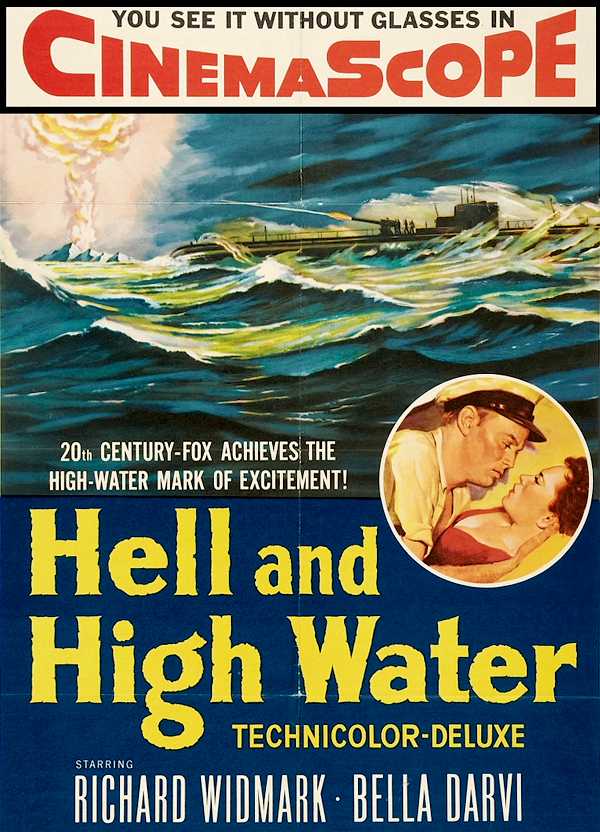
HELL AND HIGH WATER, 20th CENTURY FOX 1954 - Hell and High Water brings an intriguing Cold War slant to a standard submarine melodrama. Richard Widmark plays a sub commander who agrees to sell his services to noted atomic scientist Victor Francen and his assistant (and daughter) Bella Darvi. Francen intends to prove that the Communists intend to launch a nuclear attack on Korea from an Arctic island, then blame the attack on the United States. Widmark frankly doesn’t give a fig about politics, but he is won over by the sincerity of Francen and his idealistic cohorts, and by the beauty of Ms. Darvi. Before the Reds’ evil intentions can be thwarted, however, Widmark must face down a Communist Chinese submarine loaded with highly volatile atomic weaponry. The special effects are very impressive, especially for a mid-1950s 20th Century-Fox production.
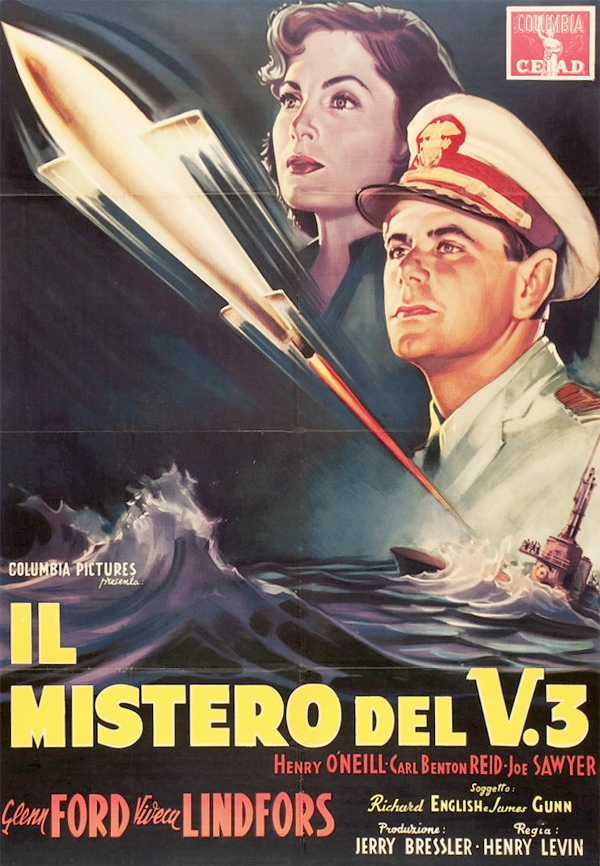
THE FLYING MISSILE, COLUMBIA 1950 - Cold War era film starring Glenn Ford and Viveca Lindfors. Made with the cooperation of the US Navy, it is a fictionalised account of the, only then recently revealed story, of the US Navy’s first firing of submarine-based cruise missiles.
WE DIVE AT DAWN, GUAMONT 1943 - Is a war film directed by Anthony Asquith, starring John Mills and Eric Portman as Royal Navy submariners in the Second World War. It was written by Val Valentine and J. B. Williams with un-credited assistance from Frank Launder. It was produced by Edward Black. The mission is to sink the Brandenburg in a mini-submarine called the Sea Tiger.
DESTINATION TOKYO 1943, WARNER BROS - Destination Tokyo ranks as one of the most intelligent of wartime thrillers. Cary Grant is a tower of strength as Captain Cassidy, skipper of American submarine USS Copperfin, bound for Tokyo harbor. Its mission: to allow a Navy meteorologist to survey Japanese weather conditions, in preparation for a major Allied assault, the Doolittle Raid. Tony Curtis enlisted in the United States Navy after Pearl Harbor was bombed and war was declared. Having been inspired by Grant’s role, he chose submarine duty and served aboard USS Proteus. The film also influenced Ronald Reagan (according to his autobiography) in his decision to accept the lead as a World War II-submarine captain in the 1957 movie Hellcats of the Navy.
ATLANTIC CONVOY 1942, COLUMBIA - Released shortly after the similar Columbia wartime story Submarine Raider, Atlantic Convoy is set on the coast of Iceland. Civilian weatherman Carl Hansen (John Beal) is suspected of being a Nazi spy after an unexpected enemy attack on an Allied convoy. With the help of nurse Lida Adams (Virginia Field), Beal not only proves his innocence but also rounds up a gang of Fifth Columnists.
THE INVADERS 1941, COLUMBIA - AKA 49th Parallel – German U-boat (U-37) terrorizes Allied shipping in the Gulf of St. Lawrence. Trying to evade Canadian Military Forces, U37 high-tails it up to Hudson Bay. The U-boat’s fanatical Nazi captain sends members of his crew ashore to look for food and supplies at a Hudson Bay Company outpost. As the landing party reaches the shore, the U-boat is spotted and sunk by the Canadians. The group of Nazi naval officers and crewmen are now stranded on Canadian soil. The Nazi Lieutenant plans his crews’ return to the Fatherland by going overland; seeking refuge in the neutral United States.
LINKS:
http://delaurentiisco.com/
https://www.warnerbros.co.uk/
http://www.sonypictures.com/
http://www.columbiatristar.co.uk/
http://www.bbc.co.uk/news/
http://www.icsu.org/
http://www.baesystems.com/
http://news.sky.com/
http://www.mpaa.org/
https://www.cia.gov/index.html
http://www.defense.gov/
https://pentagontours.osd.mil/
http://www.cbsnews.com/
LIST OF SUBMARINE MOVIES - WIKIPEDIA
This is a list of movies as posted on Wikipedia.
They are grouped by era, in which a submarine plays a significant role in the storyline. Many submarine movies are set in World War II or during the Cold War, with varying degrees of fictional elements. Some movies depict historical events from actual battles or incidents, such as Above Us the Waves, a 1955 film which depicts the true story of the British Royal Navy's midget submarines attacks on the
Tirpitz. Other submarine movies develop a fictional plot created using submarine types and tactical or technological issues that are associated with these conflicts, such as the film U-571, which tells the story of a fictional
U-boat in World War II. In some cases, these fictional submarine films may weave together some details from actual events. Other submarine films from the fantasy or science fiction film genres depict entirely fictitious events, such as the various film versions of Jules Verne's novel
20,000 Leagues Under the
Sea. The movie outline featured on this page
for Operation Neptune, is a mixture of real
submarines and warships with a fictional plot
and the inclusion of the latest patent
design for an unmanned, or drone
submarine hunter-killer.
Pre-1900
-
The Hunley 1999 — CSS Hunley
Pre-World War II
-
Pimple's Dream of Victory 1915 — UK Comedy-Short silent directed by Fred Evans, Joe Evans depicting US sailor day-dreaming of submariner adventures
-
The Secret of the Submarine 1915 — US Action-Adventure silent serial directed by George L. Sargent depicting prevention of US submarine from falling into enemy hands
-
A Submarine Pirate 1915 — US Heist-Comedy-Short directed by Charles Avery & Syd Chaplin depicting waiter attempting to foil sea-heist of gold-filled cargo vessel by submarine; AKA Submarine Stor'y, AKA Submarino Pirata
-
Civilization 1916 — US Allegorical-Drama directed by Reginald Barker, Thomas H. Ince, Raymond B. West, et al. depicting pacifist German Count's construction of submarine with order to sink ocean liner Lusitania presumably also carrying enemy munitions; AKA La cruz de la humanidad, AKA Civilização
-
A Devil at His Elbow 1916 — US Drama directed by Burton L. King depicting engineer preparing new submarine for US government under approaching deadline encounters his worst nightmare
-
The Hero of Submarine D-2 1916 — US Drama directed by Paul Scardon depicting Naval Academy official reassigned as submarine commander discovers Ruanian (fictional for "German") plot to destroy US Navy fleet; AKA Colton, U.S.N.
-
Might and the Man 1917 — US Drama directed by Edward Dillon depicting
-
The Showdown 1917 — US Drama directed by Lynn F. Reynolds depicting wealthy passengers aboard ocean liner sunk by German U-boat marooned on deserted isle; AKA Back to the Primitive
-
The Slacker's Heart 1917 — US Drama directed by Frederick J. Ireland depicting US pacifist supports war effort after submarine carrying his family is torpedoed by German U-boat
-
El milagro del Tepeyac 1917 — Mexican Drama directed by Carlos E. González, José Manuel Ramos & Fernando Sáyago depicting ship of Mexican diplomat on diplomatic mission to Europe torpedoed by German U-boat; AKA Tepeyac
-
The Little American 1917 — US Action-Drama directed by Cecil B. DeMille & Joseph Levering depicting ship of young American returning to ancestral French home torpedoed by German U-boat & witness to German brutality while imprisoned; AKA A Pequena Americana, AKA La petite américaine
-
Hunting the U-Boats 1918 — US Comedy-Short directed by Bud Fisher [animated film]
-
On the Jump 1918 — US Comedy directed by Raoul Walsh depicting US reporter joins Liberty Loan campaign before he must rescue girlfriend & stolen secret fuel formula from German agent rendezveauing with German U-boat
-
Over the Top 1918 — US Drama directed by Wilfrid North depicting German U-boat commander whose submarine transports kidnapped US woman to his headquarters in Belgium before her US beau in British service can attempt behind enemy lines rescue
-
Patriotism 1918 — US Mystery-Drama directed by Raymond B. West depicting search in Scotland for German agent sending vital information to German U-boat fleet off of Scottish coast
-
The Spreading Evil 1918 — US Drama directed by James Keane depicting ship of German chemist with cure for syphilis on way to New York torpedoed by US submarine
-
Behind the Door 1919 — US Action-Drama directed by Irvin Willat depicting German-American naval officer takes revenge against the German U-boat commander who brutalized his wife after sinking his ship; AKA Detrás de la puerta
-
Crimson Shoals 1919 — US Drama directed by Francis Ford depicting thief using submarine to steal coral from island
-
The False Faces 1919 — US Espionage-Drama directed by Irvin Willat depicting thief who becomes reluctant US agent infiltrates German U-boat to deliver vital enemy information; AKA The Lone Wolf
-
The Isle of Conquest 1919 — US Adventure-Drama directed by Irvin Willat based on Arthur Hornblow novel man & woman marooned on deserted isle after their ship is sunk by German U-boat; AKA By Right of Conquest, AKA The Broken Barrier, AKA The Call of Nature
-
The Light of Victory 1919 — US Espionage-Drama directed by William Wolbert depicting young alcoholic US Navy officer court-martialed for losing vital documents to German spies & exiled to Pacific island before providing sensitive information to German submarine planning to sink his former ship USS ''Victory''
-
The Littlest Scout 1919 — US Drama directed by Paula Blackton depicting children kidnapped by German spies rescued by Boy Scouts and help capture spies & their German U-boat
-
Unknown Love 1919 — US Romance-Drama directed by Léonce Perret depicting young woman traveling to Europe to visit injured US soldier before ship is sunk by German U-boat; AKA Stars of Glory
-
The Woman of Mystery 1920 — US Action-Adventure directed by Grace Cunard & Francis Ford depicting submarines & submarine train; edited with additional footage from 1914 silent film serial Lucille Love: The Girl of Mystery
-
Mare Nostrum 1926 — directed by Rex Ingram
-
Submarine 1928 — directed by Frank Capra
-
Men Without Women 1930 — fictional USS S-13
-
The Sea Ghost 1931 — AKA U-67
-
Morgenrot 1933
-
Hell Below 1933 — USS AL-14
-
Submarine D-1 1937
-
The Spy in Black 1939 — AKA U-Boat 29
-
Thunder Afloat 1939
-
Phantom Submarine U67 1939 — US Action-Thriller directed by William Nigh depicting US Navy captain at odds with German U-boat Captain & search for sunken treasure
World War II
-
Three Little Sew and Sews 1939 — US Comedy-Short directed by Del Lord depicting Three Stooges as sailors working in a ships' tailor shop tricked into stealing submarine by Nazi spies
-
The Phantom Submarine 1940 — US Action-Mystery directed by Charles Barton
-
Uomini sul fondo 1941 — Italian submarine collides with a ship and sinks, it's rescued with one crew member's sacrifice.
-
49th Parallel (film) 1941 — a U-boat is sunk in Hudson's Bay leaving the surviving crewmen stranded in northern Canada.
-
U-Boote westwärts (U-Boat, Course West!) 1941 — German war film promoting Kriegsmarine & Unterseeboot service
-
Alfa Tau! 1942 — history of Italian submarine Enrico Toti
-
Submarine Raider 1942 — fictional Sea Serpent vs. Hiranamu
-
Crash Dive 1943 — fictional USS Corsair
-
Destination Tokyo 1943 — fictional USS Copperfin
-
Gung Ho 1943 — fictional account of the Makin Island raid
-
The Silver Fleet 1943 — British Drama directed by Vernon Sewell & Gordon Wellesley depicting Dutch submarine builder forced to work for Nazis
-
Submarine Alert 1943 — US Thriller directed by Frank McDonald depicting former gangster supplying German U-boat commanders with torpedoes in South America
-
Submarine Base 1943 — US Drama directed by Albert H. Kelley depicting Nazi spies using stolen shortwave transmitter prototype to broadcast top secret shipping info to offshore Imperial Japanese Navy submarine
-
We Dive at Dawn 1943 — UK Action-Drama directed by Anthony Asquith depicting fictional submarine HMS ''Sea Tiger'' on mission to sink fictional German battleship Brandenburg
-
The Damned 1947 — directed by Rene Clement
-
Mystery Submarine 1950 — directed by Douglas Sirk depicting mission to destroy U-boat off coast of South America; AKA Phantom Submarine
-
Operation Pacific 1951 — fictional USS Thunderfish
-
Submarine Command 1951 — US Drama directed by John Farrow depicting US submarine commander forced to confront consequences of sudden high-sea submersion while crew remain outside sub; AKA The Submarine Story
-
Ubåt 39 (U-Boat 39) 1952 — Swedish Drama directed by Hampe Faustman depicting crew of U-39
-
Torpedo Alley 1953 — US Drama directed by Lew Landers depicting US Navy pilot rescued at sea by submarine before applying for submarine duty; AKA Down Periscope
-
Above Us the Waves 1955 — Royal Navy midget submarines v. Tirpitz
-
U 47 – Kapitänleutnant Prien 1958 — Somewhat factual combat career of Günther Prien
-
La grande speranza (Submarine Attack) 1965 — Italian Action-Romance directed by Duilio Coletti depicting Italian submarine sinking Allied shipping during Battle of the Atlantic; AKA Torpedo Zone
-
Hellcats of the Navy 1957 — fictional USS Starfish
-
The Enemy Below 1957 — US Action-Drama directed by Dick Powell depicting duel between American destroyer escort & German U-boat in South Atlantic
-
Sea Wife 1957 — US Action-Drama film directed by Bob McNaught and starring Richard Burton and Joan Collins depicting a cargo ship dangerously jammed to excess capacity with British and other evacuees fleeing the 1942 Jap invasion and Battle of Singapore that is sunk by a Japanese Imperial Navy submarine. One scene in the movie depicts the submarine underwater while the other scene depicts the submarine on the surface.
-
Run Silent, Run Deep 1958 — fictional USS Nerka (which loosely shares plot elements and the villain destroyer captain, Bungo Pete, with Edward L. Beach's novel, but not much of the plot)
-
Submarine Seahawk 1958 — US Action-Drama directed by Spencer Gordon Bennet depicting US submarine commander with reconnaissance mission to locate fleet of Imperial Japanese Navy fighting ships; AKA Submarine X-2
-
Torpedo Run 1958 — US Drama directed by Joseph Pevney depicting US submarine commander confronted with destroying Imperial Japanese Navy ship with Allied prisoners & civilians
-
Operation Petticoat 1959 — US Comedy directed by Blake Edwards depicting fictional USS Sea Tiger; remade in 1977 TV series Operation Petticoat
-
Orzeł (The Eagle) 1959 — Polish Drama directed by Leonard Buczkowski depicting ORP Orzeł & Orzeł incident
-
Up Periscope 1959 — US Drama directed by Gordon Douglas depicting US Navy frogman on mission aboard submarine to be smuggled into Japanese-held island; AKA Up Periscope!
-
McHale's Navy (TV series), McHale and His Schweinhunds [Season 2, Episode 3] 1963 — US Comedy episode directed by Sidney Lanfield depicting PT Boat crew destroying German U-boat rendezvousing with a Japanese patrol
-
Mystery Submarine 1963 — UK Action-Drama directed by C.M. Pennington-Richards depicting British captured U-boat used for mission
-
Beta Som (Torpedo Bay) 1963 — Italian-French Drama directed by Charles Frend & Bruno Vailati depicting British warship & Italian submarine operating in Strait of Gibraltar & meeting in neutral Rick's Cafe; AKA Défi à Gibraltar
-
Morituri 1965 — US Drama directed by Bernhard Wicki depicting German blackmailed by English to impersonate SS officer aboard ship; AKA Saboteur: Code Name Morituri
-
McHale's Navy (TV series), 36-24-73 [Season 4, Episode 23] 1966 — US Comedy episode directed by Hollingsworth Morse depicting PT Boat crew capturing German U-boat
-
Submarine X-1 1969 — X class submarines
-
Murphy's War 1971
-
Papanikolis 1971 Greek movie
-
Operation Petticoat (TV series) 1977–79 — Comedy directed by Hollingsworth Morse depicting fictional USS Sea Tiger; spinoff of 1959 film Operation Petticoat producing 32 episodes
-
1941 1979 — US Comedy directed by Steven Spielberg depicting Imperial Japanese Navy submarine terrorizing California coast
-
War and Remembrance (TV Miniseries) 1988
-
Below 2002 — fictional USS Tiger Shark (horror)
-
In Enemy Hands 2004 — fictional USS Swordfish and U-429; AKA U-Boat
-
Ghostboat 2006 — Mystery-Thriller based on George E. Simpson & Neal R. Burger novel & directed by Stuart Orme depicting fictional HMS Scorpion lost during World War II & resurfacing near end of Cold War
-
真夏のオリオン (Battle under Orion) 2009 — Japanese Action-Drama directed by Tetsuo Shinohara depicting Imperial Japanese Navy submarine against US Destroyer near end of war; AKA Manatsu no Orion, Last Operations Under the Orion
-
The Sinking of the Laconia 2010 — British-German historical drama directed by Uwe Janson about the sinking of the former British ocean liner RMS Laconia by U-156, which then, with three other U-boats (including U-507) and an Italian submarine, attempted to rescue nearly 2,000 passengers
-
USS Seaviper 2012 — US submarine must intercept U-Boat out of Kiel carrying Uranium 235 to a Japanese destroyer near Sumatra. Directed by Ralph A. Villani.
-
Subconscious 2014 — US submarine goes back in time to win WW II by bringing information back into the past. Directed by Georgia Hilton.
Korean War
-
Submarine Command 1951 — fictional USS Tiger Shark
-
Torpedo Alley 1952 — US Drama directed by Lew Landers depicting US Navy pilot rescued at sea by submarine in WWII before applying for submarine duty in time for Korea; AKA Down Periscope
Cold War
-
Morning Departure 1950 — British drama directed by Roy Ward Baker depicting crew of sunken British submarine trapped on the sea floor; AKA Operation Disaster
-
Hell and High Water 1954 — American action-adventure directed by Samuel Fuller depicting World War II surplus Japanese submarine battling Chinese submarine
-
On the Beach 1959, — fictional nuclear submarine USS Sawfish (SSN-623)
-
The Atomic Submarine 1959 — fictional USS Tiger Shark
-
Voyage to the Bottom of the Sea 1961 — Adventure-SciFi directed by Irwin Allen depicting fictional SSRN Seaview; remade in 1964 TV series Voyage to the Bottom of the Sea
-
Voyage to the Bottom of the Sea (TV series) 1964 — Adventure-SciFi directed by Jus Addiss depicting fictional SSRN Seaview; spinoff of 1961 film Voyage to the Bottom of the Sea
-
The Bedford Incident 1965
-
The Russians Are Coming, the Russians Are Coming 1966 — American comedy directed by Norman Jewison depicting fictional Soviet submarine Спрут; AKA The Russians Are Coming! The Russians Are Coming!
-
Ice Station Zebra 1968 — fictional USS Tigerfish (SSN-509) (In novel: USS Dolphin)
-
Mission Impossible (TV series), Submarine [Season 4, Episode 7] 1969 — American action-adventure episode directed by Paul Krasny depicting former SS officer with plans to fund Neo-Nazis
-
The Boatniks 1970 — Comedy directed by Norman Tokar depicting a salami in a submarine torpedo tube
-
Assault on the Wayne 1971 — fictional missile submarine USS Wayne (also named in The Spy Who Loved Me)
-
Fer-de-Lance (film) 1974 — fictional submarine USS Fer-de-Lance
-
The Spy Who Loved Me — 1977 American, British & Soviet submarines
-
Gray Lady Down 1978 — fictional USS Neptune
-
Raise the Titanic 1980 — U.S. submarine confronts a Soviet warship and escorts salvaged Titanic to port
-
Firefox 1982 — U.S. submarine surfaces in polar ice cap to act as refueling station for stolen advanced Russian jet fighter "Firefox"
-
Buried on Sunday 1982 — Soviet submarine used to launch missile attack on Canada's Wonderland
-
Never Say Never Again 1983 — fictional U.S. submarine
-
The Fifth Missile 1986 — fictional USS Montana
-
Russkies 1987 — Soviet submarine
-
Full Fathom Five 1990 — fictional USS Aspen versus "Alpha Victor Three class submarine CCCP Kirov"
-
The Rift 1990 — fictional Siren II searches for lost Siren I
-
The Hunt for Red October 1990 — fictional Red October (Красный Октябрь), fictional V.K. Konovalov (В. К. Коновалов), USS Dallas (SSN-700), DSRV-1 Mystic
-
Going Under 1990 — American comedy-parody directed by Mark W. Travis depicting fictional submarine USS Standard in race with Soviets to retrieve nuclear weapon
-
Silent Service 1995 — JMSDF Seabat (Japan's first nuclear-powered submarine) (anime)
-
Hostile Waters 1997 — K-219
-
K-19: The Widowmaker 2002 — K-19
-
Phantom 2013 — K-129, the plot has a basis in one theory about the events aboard the Soviet submarine's final voyage
Post-Cold War
-
Crimson Tide 1995 — USS Alabama
-
Down Periscope 1996 — Comedy directed by David S. Ward depicting fictional USS Stingray (SS-161)
-
Crash Dive 1997
-
Phantom: The Submarine (유령) 1999 — South Korean action-thriller film directed by Byung-chun Min, depicting South Korea's fictional first nuclear submarine, the ROKS Yuryong, aka Yuryeong, a former Russian Sierra-class submarine.
-
On the Beach 2000 — fictional Los Angeles-class submarine, USS Charleston (SSN-704)
-
Phantom Below 2005
-
Depth Charge 2008
-
Last Resort (TV series) 2012-13 — fictional Ohio-class submarine, USS Colorado (SSBN-753)
Future or Fantastic Past
-
Le voyage à travers l'impossible (An Impossible Voyage) 1904 — French Adventure-Comedy silent-short directed by Georges Méliès depicting Geographic Society members on around-the-world journey using various modes of transport including submarine; AKA The Voyage Across the Impossible, AKA The Impossible Voyage; predecessor to 1907 silent film 20000 lieues sous les mere
-
The Aerial Submarine 1910 — UK Adventure-Fantasy silent-short directed by Walter R. Booth depicting hybrid submarine used for high-seas heist; AKA Aerial Submarine: A Startling Forecast - Piracy on Sea and in Air
-
20,000 Leagues Under the Sea 1907, 1916, 1954, 1997, 1997 — Jules Verne's fictional Nautilus (science fiction/fantasy)
-
The Fabulous World of Jules Verne 1958 — based on Jules Verne's Facing the Flag featuring the HMS Sword
-
The Three Stooges in Orbit 1962 — Comedy directed by Edward Bernds depicting Three Stooges assisting inventor with new military hybrid (tank, helicopter, submarine) vehicle to aid in defense of Martian invasion
-
Stingray (TV Series) 1964-1965 — Adventures of the WASPs (the World Aquanaut Security Patrol) (Supermarionation)
-
Proteus a.k.a. U-91035 1966 — Directed by Richard Fleischer (science fiction/fantasy)
-
Yellow Submarine 1968 — (psychedelic fantasy)
-
Captain Nemo and the Underwater City 1969 — Jules Verne's fictional Nautilus (science fiction/fantasy)
-
The Neptune Factor 1973 — undersea rescue (science fiction)
-
The Land That Time Forgot 1975 — depicts stranded World War I U-boat crew on uncharted South-Atlantic sub-continent of "Caprona"
-
The Return of Captain Nemo 1978 — Jules Verne's fictional Nautilus (science fiction/fantasy)
-
Thundersub 1979 — (anime)
-
The Abyss 1989 — fictional USS Montana (science fiction/fantasy)
-
Nadia: The Secret of Blue Water 1989 — Jules Verne's fictional Nautilus (anime)
-
seaQuest DSV 1993 — (science fiction/fantasy)
-
Super Atragon 1995 — (anime)
-
Blue Submarine No. 6 1998 — (anime)
-
The League of Extraordinary Gentlemen 2003 — Jules Verne's fictional Nautilus (fantasy)
-
Submarine 707R 2004 — (anime)
-
The Life Aquatic with Steve Zissou 2004 — USA Adventure-Comedy-Drama directed by Wes Anderson
-
Lorelei: The Witch of the Pacific Ocean 2005 — (World War 2, Science Fiction)
-
Tide-Line Blue 2005 — (anime)
-
The Land That Time Forgot 2009 — Action-SciFi directed by C. Thomas Howell depicting stranded World War II U-boat crew in time void on island inside Bermuda Triangle
-
Arpeggio of Blue Steel 2013 — (anime)
This website is Copyright © 2023 Electrick Publications
The bird logos and name Solar Navigator are trademarks. All rights reserved. In association with Max Energy Ltd, an educational charity working for world peace
